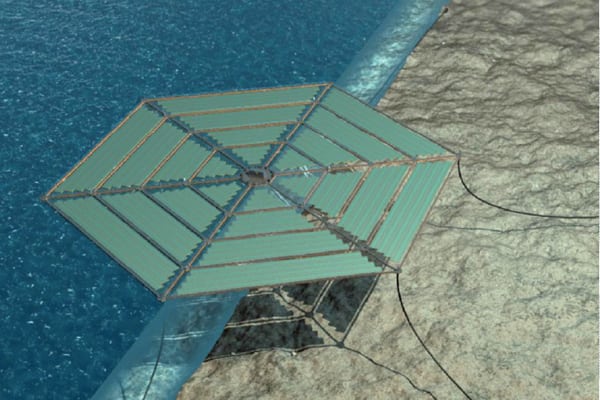Floating Solar—on Water
The recent explosive growth of massive solar plants in some of the world’s most remote deserts has stolen some of the spotlight from smaller solar installations that float on water. But in November, a concept proposed by researchers at Norwegian foundation DNV (Det Norske Veritas) for a dynamic floating offshore solar field concept stirred up myriad possibilities, particularly for congested urban regions such as coastal megacities.
The so-called “SUNdy” concept essentially involves a floating hexagonal array that can be grouped together for a power capacity of as much as 2 MW (Figure 3). Multiple islands connected together make up a solar field of 50 MW, DNV said.
 |
| 3. Rocking solar. A concept proposed by Norwegian foundation DNV calls for a hexagonal solar panel array that floats on the sea’s surface. DNV says a collection of these arrays, totaling 4,200 solar panels, could form a solar island the size of a large soccer stadium and be capable of generating 2 MW. Courtesy: DNV |
SUNdy uses thin-film 560-W photovoltaic (PV) solar panels that are flexible and lighter than the traditional rigid glass-based modules, allowing them to undulate with the ocean’s surface, as Sanjay Kuttan, managing director of the DNV Clean Technology Centre in Singapore, explained. “The key to creating an ocean-based structure of this size is the use of a tension-only design. Rather like a spider’s web, this dynamic, compliant structure yields to the waves, yet is capable of withstanding considerable external loads acting upon it.”
According to Dr. Kuttan, separating the solar arrays into prefabricated sections allows for large-scale manufacturing and streamlined assembly offshore. The cable grid provides for maintenance access in the form of floating gangways. Below the surface, the shape of the island is maintained by the tensile forces from the lengthy spread mooring.
DNV said that the island has also been optimized for solar capability and cabling efficiency. “The solar arrays are divided into electrical zones feeding electricity produced into two main switches collecting the power for voltage step up at a central transformer (2 MVA 480/34.5 kV). From the offshore solar farm’s central island, 30-kV electrical transmission lines connect, tying other islands in series to form a closed loop and continue to the electrical sub-station onshore for grid connection,” said Kevin Smith, global segment director for DNV KEMA’s Renewable Energy Services.
The concept of a floating solar array is not new, though only a handful of developers seem to be involved so far. Israeli startup Solaris Synergy in February 2011, for example, installed a modular floating concentrating PV system at the Arava Institute for Environmental Studies’ Center for Renewable Energy and Energy Conservation north of the Israeli resort town of Eilat that connects to the Israel Electric Corp. grid. Solaris Synergy has also so far signed strategic partnership agreements with Mekorot (the Israeli national water company) and French power company EDF for deployment of their first operational pilot plants of 12 to 15 kW each.
The company says it is focusing future efforts on water bodies associated with hydroelectric dams, pumped storage installations, and cooling ponds of electric power plants—locations that typically have existing power grid connections. The company claims that a massive market potential exists for the technology using these “industrial” water surfaces alone—enough to produce a total of 90 GW of solar power.
Other players include French company Sky Earth, which has operated a pilot project in the south of France since February 2011 and is now developing 12-MW and 4-MW projects in that region.
Associated drawbacks of floating solar plants have also already been established. Aside from cumbersome maintenance and repair, concerns have been voiced about solar energy concentration levels on a rocking platform. Then there are ecological and cost concerns.
—Sonal Patel is POWER’s senior writer.